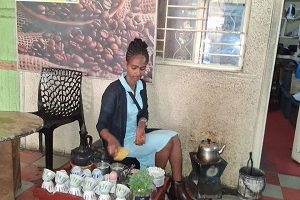
BY TSEGAY HAGOS
Ethiopia is home for more than 80 Nations, Nationalities and Peoples who have their own astounding history, language, culture, custom and tradition. The Sidama people who live in Sidama Regional State are among them. The state is found at a 4500-10,000 feet (Chama) above sea level. It boasts a temperate (Dega and Weyna dega) climate. Mount Gerembo is the highest mountain in Sidama. Sidama is known by its nickname ‘‘evergreen’’ given to it to describe the greenness of the area.
The Sidama people have colorful cultural practices which could amuse local and foreign tourists. The Fichee-Chambalaalla, which is considered by most Sidamas as the New Year of their nationality, is one of the old cultural festivals being celebrated every year. The other very peculiar culture of the Sidamas’ is their marriage custom.
There are four types of marriage systems in the Sidama society, as to Yosef Woldesenbet, Sociology and Social Anthropology expert. According to him, the most accustomed type of marriage system is one in which the father finds a wife for his son. Friends and relatives see to it. After they studied about the girl’s family linage and her personality, they try to realize her wife-hood qualities and skills. Then, the father of the son goes to the girl’s family to submit his official engagement request.
“As in any cultural communities, dowry (Chimesa) is given in the Sidama community to cement the engagement. The boy’s father gives dowry to the girl’s family as part of their agreement. But the father of the girl gives neither a positive nor negative responses immediately. He would say ‘‘we will sleep over it’’ and the boy’s father and his entourages return back to their village,’’ he noted.
For numerous reasons the girl’s family tarries to respond. The main reason is to buy time to study whether the boy has a checkered past as well as means of income. Thus, after few days, the father of the girl gives some hint that shows his favourable response. He would say “Hade ofol folshiri’’ which means ‘’take a chair, sit down’’. But the father of the boy replies “thank you so much’’ and walks out of the girl’s home. Taking this as a sign of positive response for further interactions, he pays the dowry to the girl’s family. Hence, the boy and the girl understand that their parents have reached on consensus on their relationship. Therefore, they try to familiarize each other. A market square or an area festivals take area would be preferable places for the introduction event.

‘’Then the girl understands that her engagement has become official. Before the wedding ceremony takes place she would be offered nutritious and delicious dishes. After introduction, preparation for wedding (Goshato) takes place. During the wedding day, the families, relatives and invited guests dance and sing wedding songs after locking the bride in a different room,’’ he points out, adding, ‘’the girls start to utter mocking remarks which could provoke the boy’s best men and relatives. At this time, from the boys’ side the strongest one throws open the door and forcefully hauls the bride out. The girls try everything in their power to prevent this action. But the set of boys are too strong for them to easily deter. After they arrived at the bridegroom’s home, they spend the whole night singing and dancing.’’
The second type of marriage is called Adulsha (maskoblel). It could be seen to through persuading the girl. In this type of marriage, no wedding ceremony would take place. After the boy took the girl to his parent’s home, he tells his father to go to the girl’s home to settle the issue amicably. When the son’s father comes in terms with the girl’s father, he pays dowry. After that the marriage puts down roots.
‘’Nowadays, the first marriage system is fizzling out. But the second one is becoming popular among the young generation with some modifications. However since it is accomplished through agents’ and friends’ persuasion, many young girls gets duped to engage in unwanted marriage. They become dupes that their would-be husband is famous and rich. But when they enter into real marriage what they experience will be far from what they have been imagining before,’’ according to Yosef.
The third type of marriage system is called Adewana. Such marriage custom takes place of the girl’s volition. If the girl has developed affection for the boy, she shows him signs which could lead him to reciprocate to the extent of seeking engagement. But if he fails to read the signals, she would go to his mother and tells her that she loves the boy, the expert explains. ‘’When she drops in to visit their house, the boy’s mother serves her food affectionately. In this way, the wedding ceremony would take place. This kind of marriage could make the husband boastful. He could opt to look down his wife mindful that she asked him for the relationship. Due to such reasons many divorces have been occurring.’’
The fourth type of marriage system of the Sidama people is called DIERA (Telefa). This marriage system is practiced when the above two types (Hucheto and Adulsha) fail to work. Hence, he abducts his dream object during firewood collection, water fetching, among other activities. Then, he takes her to his home. He deflowers her that night. Fierce conflict could break out if her family hears her yelling. However, if the abduction is successful, her families take it Okay as it is the culture of the society. Then after receiving dowry, her parents get ready for the wedding ceremony. Such a marriage system is not encouraged. But it is still being practiced in some parts of the society, he noted.
Generally speaking, the Sidama people have a very prideful culture and traditions. Their marriage culture has been transferred from generation to generation. Having understood its importance, the Ministry of Culture and Tourism, Culture and Tourism Bureaus and other stakeholders should work to promote, preserve and develop this wonderful cultural blessing.
The Ethiopian Herald April 3/2021





Login Laskar288 Situs Game Slot Gacor Dengan Win Rate 85% Mudah Scatter Maxwin!